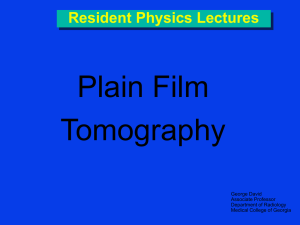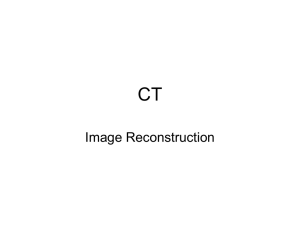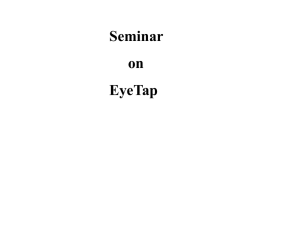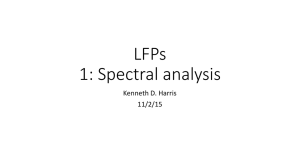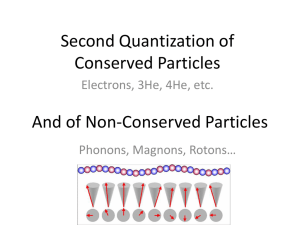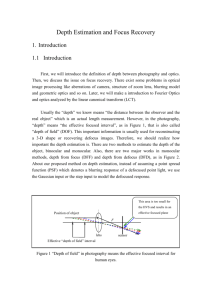Introduction to Depth Estimation and Focus Recovery
advertisement
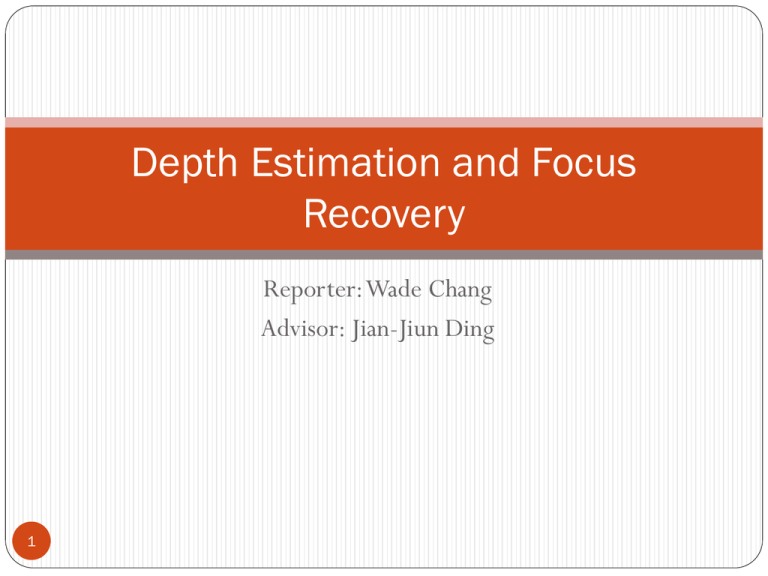
Depth Estimation and Focus Recovery Reporter: Wade Chang Advisor: Jian-Jiun Ding 1 Outline Motivation Overview Blurring model and geometric optics Blurring function Fourier optics Linear canonical transform (LCT) Depth estimation methods Binocular vision system Monocular vision system Focus recovery methods Reference 2 Outline Motivation Overview Blurring model and geometric optics Blurring function Fourier optics Linear canonical transform (LCT) Depth estimation methods Binocular vision system Monocular vision system Focus recovery methods Reference 3 Motivation Focus recovery is important, it can help users to know the detail of original defocused image. Depth is a important information for focus restoration. 4 Outline Motivation Overview Blurring model and geometric optics Fourier optics Linear canonical transform (LCT) Blurring function Depth estimation methods Binocular vision system Monocular vision system Focus recovery methods Reference 5 Blurring Model and Geometric Optics(1) What is the perfect focus distance? 1 1 1 f s z Why does the blurring image generate? This area is too small for the HVS and results in an effective focused plane z s Position of object 。 。 。 。 。 。 。 。 。 F lens Effective “depth of field” interval 6 。 。 。 sensor 。 。 。 Blurring Model and Geometric Optics(2) Ideal and real spherical convex lens Ideal spherical convex lens Aspherical convex lens 7 Real spherical convex lens Blurring Model and Geometric Optics(3) combination of the convex lens and the concave lens Convex lens F2 Incident rays F1 8 Concave lens Blurring Model and Geometric Optics(4) Effective focal length of the combination of lenses l2 l1 Combination of the thin convex lenses F4 F1 9 F2 F3 Outline Motivation Overview Blurring model and geometric optics Blurring function Fourier optics Linear canonical transform (LCT) Depth estimation methods Binocular vision system Monocular vision system Focus recovery methods Reference 10 Blurring Function (1) screen F F Blurring radius: R<0 D/2 s u 2R : R<0 Biconvex v F F Blurring radius: R>0 D/2 s u 2R : R>0 screen 11 v Blurring Function (2) Blurring radius relates to depth value: Ds 1 1 1 R 2 F s u FsD u sD 2 R D F Considering of diffraction, we may suppose a blurring function as: I x, y h x, y r x, y x2 y 2 h x, y exp 2 2 2 2 1 :diffusion parameter 12 h x, y : blurring function r x, y : radiance I x, y : defocus image Outline Motivation Overview Blurring model and geometric optics Blurring function Fourier optics Linear canonical transform (LCT) Depth estimation methods Binocular vision system Monocular vision system Focus recovery methods Reference 13 Fourier Optics(1) Aperture effect(Huygens-Fresnel transform) When a plane wave progress through aperture, the observed field is a diffractive wave generated from the rim of aperture. ... . .. 14 Fourier Optics(2) Where the examples are through Huygens-Fresnel transform at z=1 meter, z=14 meters and z=20 meters respectively. Square wave After Huygens-Fresnel Transform z=1 x-axis [0,200] x-axis [0,200] x-axis [0,200] 15 Square wave After Huygens-Fresnel Transform z=20 y-axis [0,200] Square wave After Huygens-Fresnel Transform z=14 y-axis [0,200] y-axis [0,200] y-axis [0,200] Square wave Before Huygens-Fresnel Transform x-axis [0,200] Outline Motivation Overview Blurring model and geometric optics Blurring function Fourier optics Linear canonical transform (LCT) Depth estimation methods Binocular vision system Monocular vision system Focus recovery methods Reference 16 Linear Canonical Transform (1) Why we use Linear canonical transform? Definition LM f u LM u, u ' f u ' du ' : D 2 1 A 2 L u , u ' 1 / B exp j / 4 exp j u 2 uu ' u ' for B 0, M B B B L f u D exp j CDu 2 f D u for B=0 M 2 17 Linear Canonical Transform (2) Effects on time frequency analysis can help us realize most properties by changing those four parameters. Let us consider one of time frequency analysis-Gabor transform: t 2 g e j 2 f d G t , f exp 2 After g ( ) is substituted as a LCT signal, the result in a new coordinate on time and frequency is as follows. At Bf '2 g ' exp j 2 Ct Df ' d G t ', f ' exp 2 18 t ' A B t f ' C D f Linear Canonical Transform (3) Characteristics Function representation Chirp multiplication Chirp convolution exp j qu 2 u u ' exp j / 4 1 / r exp j u u ' / r Fourier transform Scaling 19 1 i cot icot 2 /2 e 2 Fractional Fourier transform 2 e Transforming parameters 1 0 q 1 1 r 0 1 cos / 2 sin / 2 sin / 2 cos / 2 icsc t icot t 2 /2 exp j / 4 exp j 2 uu ' S u Su ' 0 1 1 0 0 S 0 1/ S Linear Canonical Transform (4) Consider a simple optical system. z Uo s Ul Ul’ Ui The equivalent LCT parameter: 1 A B 1 s C D 0 1 1 f 20 s 1 0 f 1 z 1 0 1 1 f zs s f z 1 f z Linear Canonical Transform (4) Special case of an optical system f f f : focal length Uo Ul Ul’ 1 A B 1 f C D 0 1 1 f 0 A B 1 C D f 0 1 f 1 0 1 f f 0 0 Ui 0 1 f scaling 21 0 1 1 0 Fourier transform Outline Motivation Overview Blurring model and geometric optics Blurring function Fourier optics Linear canonical transform (LCT) Depth estimation methods Binocular vision system Monocular vision system Focus recovery methods Reference 22 Binocular Vision System(1) 23 Binocular Vision System(2) Binocular vision at a gazing point. sin 2 L R cos 2 L cos 2 R u B 4sin 2 sin 2 L R L R 2 2 Gazing point (Corresponding point) g L Depth (u) B/2 B/2 Baseline (B) 24 R Outline Motivation Overview Blurring model and geometric optics Blurring function Fourier optics Linear canonical transform (LCT) Depth estimation methods Binocular vision system Monocular vision system Focus recovery methods Reference 25 Monocular Vision System(1) Method 1: Utilizing diffusion parameter to calculate depth value. kDs1 1 1 1 1 2 F s1 u kDs2 1 1 1 2 2 F s u 2 F F u D / 2 s 2R : R>0 scr een v 26 Blurring radius: R>0 Monocular Vision System(2) Using power spectral density to calculate depth value. ; exp 2 I f x , f y H f x , f y ; i R f x , f y , i i | i different depth region H fx , f y P fx , f y e i 4 i 2 2 f x 2 f y 2 2 f x2 f y2 2 i R f , f R* f , f x y x y P1 f x , f y 4 2 i12 i 22 f x 2 f y 2 e P f , f 2 x y 27 2 1i 2i 2 1 Aw w P1 f x , f y 4 2 ln f x 2 f y 2 P2 f x , f y df x df y Monocular Vision System(3) Method 2: Take differentiation on equation I which respect to i . I f x , f y i H f ,f x I fx , f y i kD 1 1 s 2 F u 28 y; i R f x , f y 4 i 2 f x 2 f y 2 4 f 2 i 2 x f y2 I f x , f y s I f , f 4 f 2 x y replace i 2 x f y2 kDs 1 1 1 2 F s u kD 1 1 i 2 F u Monocular Vision System(4) Method 3: Using LCT blurring models z Uo 1 A B 1 s C D 0 1 1 f 1 A B D C D C 29 B A s Ul Ul’ Ui s 1 0 1 z f 1 0 1 1 f zs s f z 1 f z Outline Motivation Overview Fourier optics Linear canonical transform (LCT) Blurring function Depth estimation methods Binocular vision system Monocular vision system Focus recovery methods Reference 30 Focus Recovery Methods(1) Derive MMSE filter 31 Focus Recovery Methods(2) Derive MMSE filter 32 Focus Recovery Methods(3) Derive Wiener Filter: s( x, y) : ideal image sˆ( x, y) : final image e( x, y) : noise h( x, y) : po int spread function r ( x, y) : sharpening filter e( x, y) : noise 33 Reference [1] M. Robinson, D. Stork, “Joint Design Lens Systems and Digital Image Processing” [2] P. C. Chen, C. H. Liu, ”Digital Decoding Design for Phase Coded Imaging” [3] Y. C. Lin, “Depth Estimation and Focus Recovery” 34 Thank You for Listening 35

